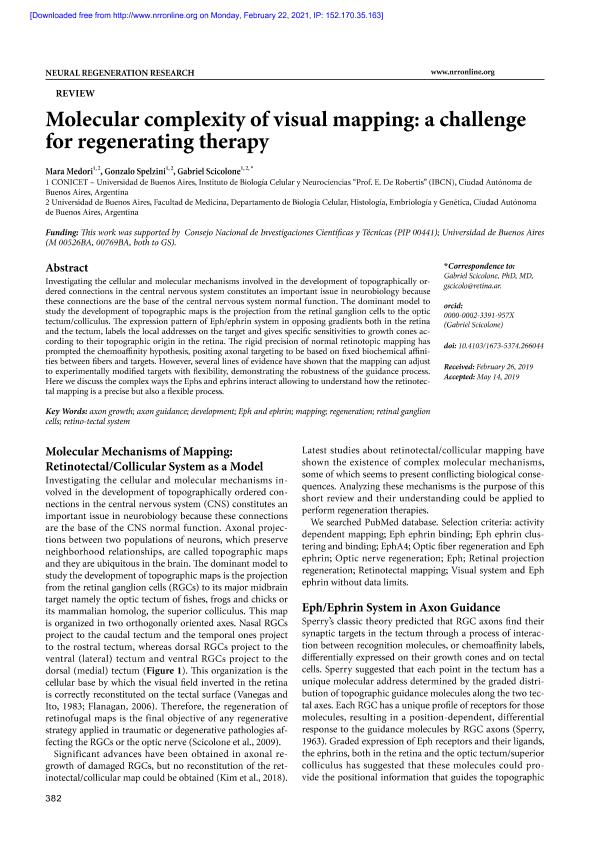Mostrar el registro sencillo del ítem
dc.contributor.author
Medori, Mara Solange

dc.contributor.author
Spelzini, Gonzalo Nicolás

dc.contributor.author
Scicolone, Gabriel Edgardo

dc.date.available
2021-02-22T12:44:41Z
dc.date.issued
2019-09
dc.identifier.citation
Medori, Mara Solange; Spelzini, Gonzalo Nicolás; Scicolone, Gabriel Edgardo; Molecular complexity of visual mapping: A challenge for regenerating therapy; Shenyang Editorial Dept Neural Regeneration Res; Neural Regeneration Research; 15; 3; 9-2019; 382-389
dc.identifier.issn
1673-5374
dc.identifier.uri
http://hdl.handle.net/11336/126177
dc.description.abstract
Investigating the cellular and molecular mechanisms involved in the development of topographically ordered connections in the central nervous system constitutes an important issue in neurobiology because these connections are the base of the central nervous system normal function. The dominant model to study the development of topographic maps is the projection from the retinal ganglion cells to the optic tectum/colliculus. The expression pattern of Eph/ephrin system in opposing gradients both in the retina and the tectum, labels the local addresses on the target and gives specific sensitivities to growth cones according to their topographic origin in the retina. The rigid precision of normal retinotopic mapping has prompted the chemoaffinity hypothesis, positing axonal targeting to be based on fixed biochemical affinities between fibers and targets. However, several lines of evidence have shown that the mapping can adjust to experimentally modified targets with flexibility, demonstrating the robustness of the guidance process. Here we discuss the complex ways the Ephs and ephrins interact allowing to understand how the retinotectal mapping is a precise but also a flexible process.
dc.format
application/pdf
dc.language.iso
eng
dc.publisher
Shenyang Editorial Dept Neural Regeneration Res

dc.rights
info:eu-repo/semantics/openAccess
dc.rights.uri
https://creativecommons.org/licenses/by-nc-sa/2.5/ar/
dc.subject
DEVELOPMENT
dc.subject
REGENERATION
dc.subject
RETINO-TECTAL SYSTEM
dc.subject
AXON GROWTH
dc.subject
MAPPING
dc.subject
EPH AND EPHRIN
dc.subject.classification
Neurociencias

dc.subject.classification
Medicina Básica

dc.subject.classification
CIENCIAS MÉDICAS Y DE LA SALUD

dc.subject.classification
Biología del Desarrollo

dc.subject.classification
Ciencias Biológicas

dc.subject.classification
CIENCIAS NATURALES Y EXACTAS

dc.title
Molecular complexity of visual mapping: A challenge for regenerating therapy
dc.type
info:eu-repo/semantics/article
dc.type
info:ar-repo/semantics/artículo
dc.type
info:eu-repo/semantics/publishedVersion
dc.date.updated
2020-12-09T20:16:55Z
dc.journal.volume
15
dc.journal.number
3
dc.journal.pagination
382-389
dc.journal.pais
China

dc.journal.ciudad
Shenyang
dc.description.fil
Fil: Medori, Mara Solange. Consejo Nacional de Investigaciones Científicas y Técnicas. Oficina de Coordinación Administrativa Houssay. Instituto de Biología Celular y Neurociencia "Prof. Eduardo de Robertis". Universidad de Buenos Aires. Facultad de Medicina. Instituto de Biología Celular y Neurociencia; Argentina
dc.description.fil
Fil: Spelzini, Gonzalo Nicolás. Consejo Nacional de Investigaciones Científicas y Técnicas. Oficina de Coordinación Administrativa Houssay. Instituto de Biología Celular y Neurociencia "Prof. Eduardo de Robertis". Universidad de Buenos Aires. Facultad de Medicina. Instituto de Biología Celular y Neurociencia; Argentina
dc.description.fil
Fil: Scicolone, Gabriel Edgardo. Consejo Nacional de Investigaciones Científicas y Técnicas. Oficina de Coordinación Administrativa Houssay. Instituto de Biología Celular y Neurociencia "Prof. Eduardo de Robertis". Universidad de Buenos Aires. Facultad de Medicina. Instituto de Biología Celular y Neurociencia; Argentina
dc.journal.title
Neural Regeneration Research

dc.relation.alternativeid
info:eu-repo/semantics/altIdentifier/url/https://www.ncbi.nlm.nih.gov/pmc/articles/PMC6921353/
dc.relation.alternativeid
info:eu-repo/semantics/altIdentifier/doi/http://dx.doi.org/10.4103/1673-5374.266044
Archivos asociados
